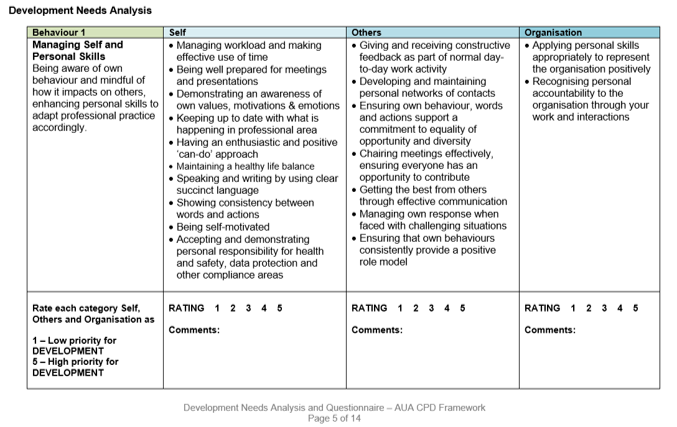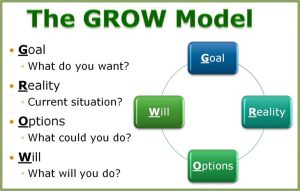Introduction to the AUA CPD Framework webinar
In this webinar two experts in using the AUA CPD Framework, Jan Shine and Michael Monaghan, provided an overview of what the framework is all about, as well as how to use it both individually and with your colleagues. The webinar and this accompanying blog provide an introduction to the framework and you can find more information and resources here.
Participants found the advice and ideas within the webinar really useful so we’re sharing some of the key takeaways with you and the rest of the AUA community. A recording of the webinar is also available at the bottom of the page for members to view.
Jan Shine FAUA
Michael Monaghan FAUA
What is the framework?
Jan began the webinar by introducing the AUA CPD Framework and giving some context to how and why it was created.
Defining features of the framework:
- Based on the AUA values
- Focus on behaviours: they are observable and describable
- Flexible: can be used by individuals, teams and whole organisations. Individuals can benefit even if it’s not used in their organisation
- Universal: all professional services roles
- Strengths as well as areas for development: which are as important and often overlooked
How the framework fits within the job
The AUA CPD Framework fits into the space between a job description and person specification to explain how the job needs to be done and the behaviours that underpin effective performance. When taken together, these three separate perspectives on a role provide a comprehensive picture of the expectations of effective performance in the role.
Benefits of the framework:
- Unique way for colleagues to look at their development
- Enhances engagement with and experience of appraisal
- Increased sense of professional identity and worth
- Highly adaptable framework as evidenced by Mark of Excellence awards
- Complements and can be integrated with other frameworks
- Common language fosters cross-boundary and partnership working
Using the framework to develop yourself
Here are some practical ways that you can engage with the framework for personal development.
Self-assessment
• Acknowledging achievements and strengths
• Identifying areas for development
Personal Development Planning
• Setting CPD objectives
• Focusing and prioritising learning and development efforts
Career Planning
• Assessing readiness for career moves
• Structuring HE applications and CVs
Feedback
• Seeking feedback and giving feedback in a structured way
Professional recognition
• Role modelling excellence in FE/HE administration and management
• Enhancing professional identity
We have lots of positive feedback in particular from those who have used the framework not only for formal appraisals but also more informal conversations around development with colleagues.
There are also several activities you can complete which will help you to apply the framework to your context and therefore understand how it can aid your development. These include the self-assessment wheel, determining your priorities by choosing several of the most relevant behaviours to concentrate on, and mapping your role to the framework. These activities are designed to allow you to understand the most important areas of the framework for your role so that you can easily prioritise your development.
The following questions can be a useful aid to applying the framework in your context:

Michael began his section by continuing to discuss different ways that the framework can be used to help individuals develop.
Development Needs Analysis: This allows individuals to complete a detailed self-assessment, rating themselves for each section of the framework and providing comments for the high (or low) areas, focussing on strengths and areas for development. This is particularly helpful for individuals to complete before appraisal and before development conversations with managers, coaches or mentors.
Another important way that the framework can be used by individuals is as an articulation aid when writing reflectively, for example in job applications, learning journals and development feedback. A good approach to this is to turn relevant behaviour descriptors into a reflective statement:
e.g. Descriptor (Working together): Using understanding of other people’s perspectives to help reach agreement
Individual’s example: I consistently use understanding of other people’s perspectives to help reach agreement through/by

GROW model
Michael explained that at LJMU, staff have used self-coaching with the AUA CPD Framework to enhance their general development planning. To do this, they select an area (or descriptor) from the Professional Behaviours that they wish to develop and then use the GROW model, working through the stages and writing down their thoughts and answers for each one. At the end of this activity the staff member will have a development plan or actions to help them move forward, as well as an enhanced understanding of their experience and development options for their chosen area, and of coaching.

Develop autonomous learning skills
An effective way to improve individual self-directed learning skills through a combination of reflective writing and the framework is to encourage staff to keep short, weekly learning logs (an individual reflection on a work-related experience). Any reflective writing log can be used for a learning log but Michael recommended his self-created WHW Technique, which consists of answering three simple questions:
- What did you do? (describes the situation)
- How did you do it? (provides evidence of your actions, which demonstrates you could replicate them)
- Why did you do it? (demonstrates you understand the thought processes behind your actions)
After doing this process for some time, individuals will become much more autonomous learners. The learning logs will also allow them to develop a useful collection of reflective examples and evidence for future use within appraisals, job applications and any other development-type activities, especially applying for AUA accreditation and fellowship.
Using the framework with colleagues
In this section Michael explored several games that he has developed from the framework which can be used by managers as a creative way to engage staff.
AUA Building Behaviours
This is a spin on Jenga in which each block corresponds to a different Behaviour and when staff take a block they must give a work related example for one of the descriptor’s from the block’s Behaviour area.
Find out more.
AUA Behaviour Insights
A strategic board game which uses cards that have each of the three different sections of each Professional Behaviour on them: Self, Others and Organisation. The main benefit of this activity is demonstrating a pragmatic link or relationship with institutional values or another Framework.
AUA Creating Conversations
A card-based game encouraging critical reflection, discussion and debate around the Professional Behaviours, centred on individual and collective strengths and areas of development. This resource supports individual, team and institutional development planning.
Managers can also encourage their colleagues to carry out any of the activities highlighted in individual development, as a way to support them with self-reflection to prepare for appraisals, development and career planning.
After the session there was a Q&A:
I’ve been thinking of applying for AUA Fellowship, this session has been very helpful with regards to that but are there any exemplars to look to?
Michael: Not currently. I recommend anyone who is looking to complete fellowship within their institution is to use a peer-learning model, which the University of Bath used first in 2017 and won Network of the Year based on this model and we have since mirrored it at LJMU. This involves emailing other AUA members at the institution to see if any are also interested in applying for Fellowship. You can then dedicate some time each week to get together and review the work that you are both doing on your fellowship applications. It can be a big help having someone who is able to be constructively critical when looking at your work. I would also recommend using a reflective model to write your application.
Are there any ideas around how to use the tools that we’ve got creatively whilst we’re in a remote-working environment?
Michael: I am working on this currently and am looking at options for how these could be facilitated potentially through a screenshare option or something similar. I’m hoping to have a concept developed and piloted by the end of August and this will be shared with the AUA.
Jan: Although we have shared some ways of working with the framework with you, there are endless ways that you can do this, so don’t feel constrained by what we’ve shown you.
This recording is only viewable by AUA members. If you can’t view the recording, you may need to log in. If you are logged into the site and you still cannot view the recording, it may mean that your membership has expired – you can renew your membership in My AUA.

0 comments on “Introduction to the AUA CPD Framework”